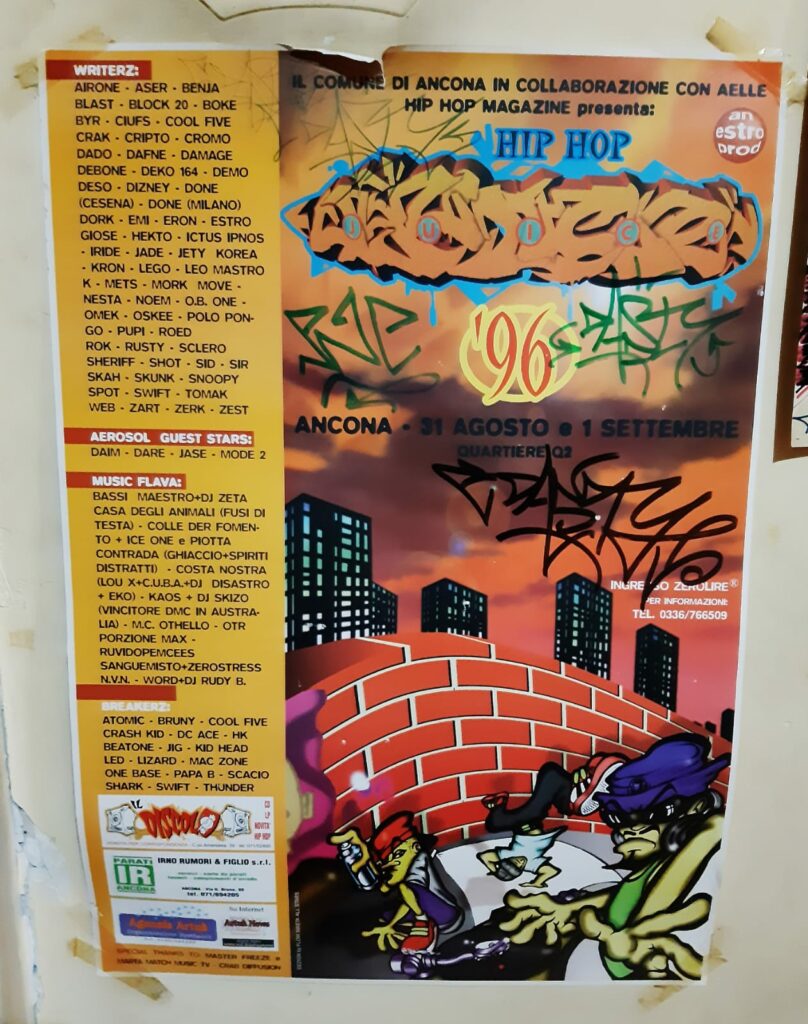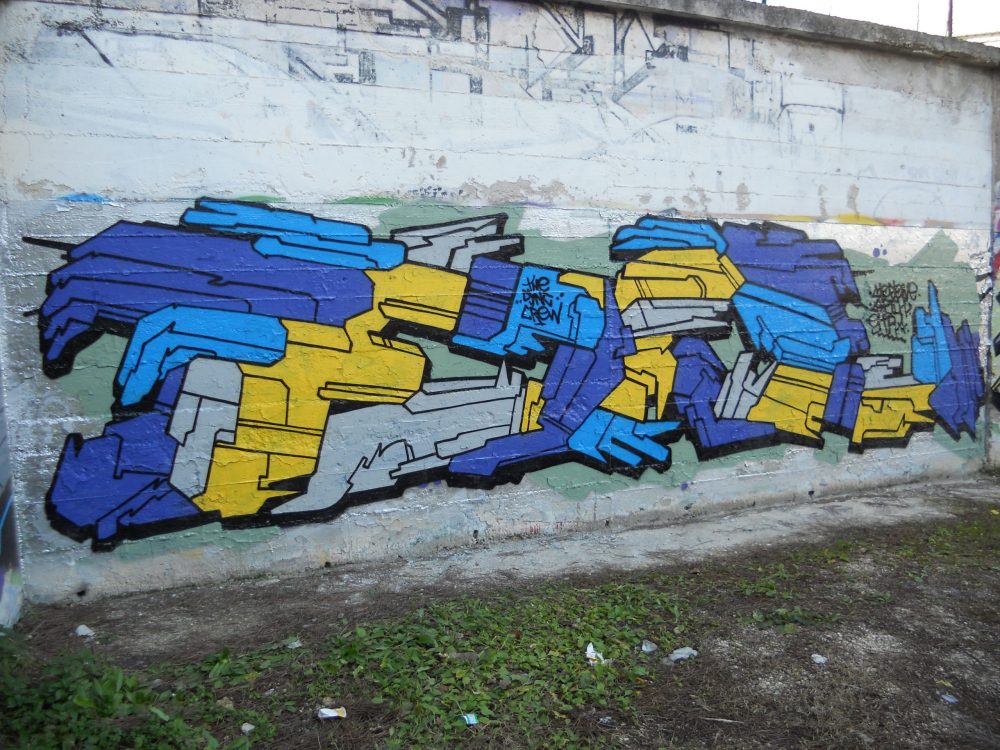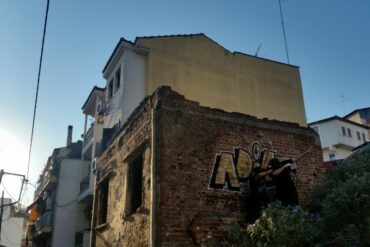Interview with the “old school” graffiti writer DASTY 314 from Marche (Italy), active since 1993
More than a year ago, thanks to social network, I’ve had the chance to start a nice chat with Dasty, a writer from Senigallia (AN, Italy). We’ve never had the chance to meet each other in person, but we’ve been talking, here and there, about graffiti writing. Most of all we used to talk about the 90’s and the first graffiti jams in Italy, something that I find very interesting, and of course also his experiences as a writer. I want to thank him for sharing his stories with me, and for this interview.
When and how did you discover graffiti writing?
I discovered writing thanks to my other great passion, that is the stadium. Since 1989 I’ve been part of the north stand of Ancona city stadium, both to the old one and the most recent one, the Conero Stadium. The first time that I’ve seen some graffiti on a wall was on 1993, during the grand opening of the new stadium: I was astonished

What do you miss the most of that period?
The motivation that people used to have. Writing used to be considered a very serious thing and it was not easy at all to be part of the scene. There was no internet back then, and the only thing you could do was trying to find a way to meet other people who had the same passion as you.
Old spray cans and old caps compared to the new ones, what do you think of their evolution?
I love the old sprays (talken and sparvar are the ones that I used the most at the beginning) and even only their intense smell is something that I can never forget. New spray cans are fantastic and technically they help a lot. About caps I can say I don’t know that much, because I always paint with the original caps.
I’d like to say that for years I have always and only used the soft new york cap with the Happy Color of Saratoga. At that time I didn’t have a lot of money but luckily a lady who had a hardware store in a small village used to sell them to us at an affordable price (2.500 lire). Apart from that we used to steal some roller paint for the background from construction sites, and this how we could paint graffiti. If I hadn’t had this opportunities I don’t think I would have come to have a personal style.

What do you think of the evolution of graffiti in Italy since the early 1990s?
I think we went from trying to have an original style to trying to have a style that is just fashionable. I have recently started an Instagram account and on the one hand I am fascinated by the way writers use it as a way to get in touch and come into contact with people from all over the world. Moreover on Instagram you can see incredible things. On the other hand I don’t see a lot of originality, compared to the past. I see “perfect pieces” that look all the same. Maybe in the past pieces had something wrong but the effect was more powerful, because it was something completely new.
You took part to some of the first graffiti jams in Italy, what is still fixed in your mind about those experiences? Any interesting or funny anecdote you’d like to share?
I had the good fortune and the opportunity to join some of the first historical graffiti jams in Italy. The first ever was called “Tinte Forti” (strong colors) and was organized at the historic wall of the Cavallazzi in Bologna in ’94 (I went there with a group of friends from Senigallia, among whom there were also Fabri Fibra and dj side). After that there was “Indelebile” (Indelible) jam in Rimini, same year, and the only I thing I can say about it is that it was amazing, seeing people like Mode 2 and Delta was like a dream. But the graffiti jam that’s more important to me is the first edition of “Juice” in 1995 (not the second one that was a massive event with people coming from all over Italy, more than 3000 writers). When I decided to take part to the Juice in 1995 I was terrified, I can still clearly remember my excitement. At that time the graffiti writing scene was so underground that I knew about it through a friend of mine who was there too, but I didn’t even know in which neighborhood they were. I was a underage and I went by bus from my village with the spray cans. I went back home at night hitchhiking.

Have you always been part of a crew?
I started as a maverick, alone, without knowing anyone. I’ve been lucky, though, because at the high school in Senigallia I could meet friends with whom I still hang out with after 30 years. My first crew was the Tmc (the massagroni crew), then in 2000 I entered in the Snc. Some years ago I have founded a crew called Icas, whose members are not only writers, but also some “mentally devastated people” like us.
What has been your evolution as a writer and how do you experience graffiti today?
I have never been a bomber, coming from a village of 3000 inhabitants it never interested me too much to do only tags (which I still think is the coolest part of writing) or throw ups. I have always been a wild styler and today I still believe that the “real writing” is the one we used to have in Milan in the early ’90s (pwd, ckc, tka crews).
Which were your points of reference when you started and who are your favorite writers today?
As I said before, apart from the whole “Milan school”, that has made history and still dominates over time, today I can’t give you an answer.

What do you think of post-graffiti abstract art?
Unfortunately, I am not that informed about these terms, also because in my opinion there is no “post graffiti”. As far as I am concerned, what I care about is only writing, I’ve never been interested in terminology. However, it is important to underline that graffiti terminology is somewhat reductive when you talk about the movement.
Can you tell me a dream that you managed to realize as a writer and another that remained a secret one?
There are many beautiful things that happened to me as a writer, but the best one is crazy people like me that I have known over the years. My dream is to bring my daughter to paint. Now she is 8 months old and I think is still a bit premature.
What do you think of your local scene?
I must admit that I’ve never got too involved in the local scene. I almost always painted with my crew members so I can’t judge the local scene. I believe that in any case we are only few writers and I think is better. I’ve never been interested in being known. I paint in a place so isolated that nobody ever sees me and I’m happy with that, what I do is for me and for a few others. Now I’m uploading photos on Instagram because I’m afraid I might lose photos of the pieces (which has already happened to me in the past).

Recently you have had the opportunity to paint with some writers of the new generation, what would you recommend to those like them who started painting recently?
I would recommend to read up seriously on what writing is and to love this passion… which is not a game, but a mission.
You recently opened an Instagram account, but how much and how do you think the world of writing has changed since the arrival of social networks?
In my opinion, writing hasn’t changed, people have changed. Before, it was much more felt, we studied a lot on paper and went to paint on a wall when we were aware of being able to do it. Today it’s all more immediate.
Do you think is still important to document somehow the history of writing in Italy in the 1990’s, early 2000?
It is essential, luckily people much more experienced than me have managed to make real writing known.
And finally a tip for me, what do you think I should do with my Urban Lives project to record the national scene?
It would be nice to organize a graffiti jam with writers from all over Italy, a good chance to meet and discuss with each other. Regards



